Over 30 years of anarchist writing from Ireland listed under hundreds of topics
Republicanism
The partition of Ireland
WSM position paper on the partition of Ireland. Last debated and updated at the April 2009 conference. It sits under the State and Democracy position paper.
The Partition of Ireland
A Workers Solidarity Movement Position Paper
1916 - Connolly, blood sacrifice and defeating British imperialism
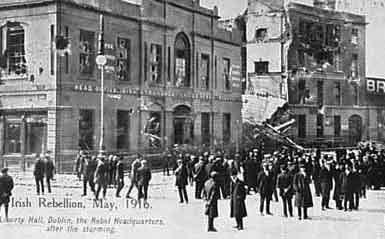 At 11.30 in the morning of April 24 1916 Bugler William Oman, a member of a syndicalist workers militia the Irish Citizen Army (ICA), sounded the 'fall-in' outside his union headquarters. This was the start of an insurrection in Dublin which was to see around 1,500 armed men and women seize key buildings throughout the city, and to hold these positions against thousands of British Army soldiers for almost a week. In the course of putting down the insurrection, 1351 people were killed or severely wounded and 179 buildings in the city centre were destroyed.(1)
At 11.30 in the morning of April 24 1916 Bugler William Oman, a member of a syndicalist workers militia the Irish Citizen Army (ICA), sounded the 'fall-in' outside his union headquarters. This was the start of an insurrection in Dublin which was to see around 1,500 armed men and women seize key buildings throughout the city, and to hold these positions against thousands of British Army soldiers for almost a week. In the course of putting down the insurrection, 1351 people were killed or severely wounded and 179 buildings in the city centre were destroyed.(1)
Image: Liberty hall after the rising
1916, left republicanism, anarchism and class struggle
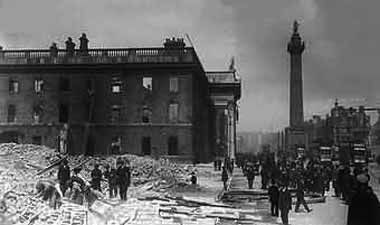 This article is an anarchist analysis of the 1916 insurrection and the war of independence in the context of the struggle for socialism in Ireland and internationally. It concentrates on the 'unknown' but intense class struggle that ran alongside the war of independence and the role republicanism played in the suppression of that struggle. It asks 'what is freedom' and shows how anarchism originated amongst earlier European left republicans as an answer to the limitations of republicanism.
This article is an anarchist analysis of the 1916 insurrection and the war of independence in the context of the struggle for socialism in Ireland and internationally. It concentrates on the 'unknown' but intense class struggle that ran alongside the war of independence and the role republicanism played in the suppression of that struggle. It asks 'what is freedom' and shows how anarchism originated amongst earlier European left republicans as an answer to the limitations of republicanism.
Image: O'Connell street after the insurrection
An anarchist opinion on the Dublin anti-loyalist march riot
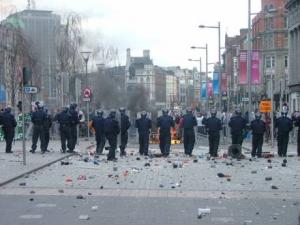 Saturday saw a major riot in Dublin in response to an attempted Loyalist 'Love Ulster' march through the main street of the capital. For three hours hundreds rioted in the city centre, banks and shops were attacked and looted and cars were set on fire. All the political parties including Sinn Fein have condemned the riots but few have analysed what happened. This article first submitted to indymedia.ie suggests the riot shows that "he who sows misery, harvests anger". The author is a WSM member living in Dublin, this is his personal view of events.
Saturday saw a major riot in Dublin in response to an attempted Loyalist 'Love Ulster' march through the main street of the capital. For three hours hundreds rioted in the city centre, banks and shops were attacked and looted and cars were set on fire. All the political parties including Sinn Fein have condemned the riots but few have analysed what happened. This article first submitted to indymedia.ie suggests the riot shows that "he who sows misery, harvests anger". The author is a WSM member living in Dublin, this is his personal view of events.
Pushers Out! - The inside story of Dublin's anti-drugs movement
Walk five minutes from O'Connell St, Dublin's main thoroughfare, or five minutes from Christ Church Cathedral, an important tourist attraction, and you will find yourself in a very different world from that depicted in the tourist brochures. Pushers Out tells the story of how people living in the North Inner City and the South Inner City (and later the suburbs, and some small towns) organised to save their communities from heroin. Not relying on the state to solve their problems, they started to organise themselves. One such working class organisation is Coalition of Communities Against Drugs (COCAD).
An anarchist look at the ideas of James Connolly - the single most important figure in the history of the Irish left
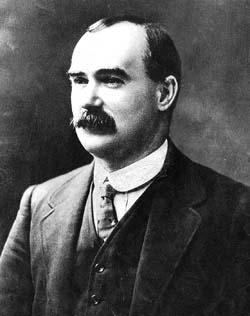 James Connolly is probably the single most important figure in the history of the Irish left. He was an organiser in the IWW in the USA but in Ireland is best known for his role in building the syndicalist phase of Irish union movement and for involving the armed defence body of that union, the Irish Citizens' Army in the 1916 nationalist insurrection. This left a legacy claimed at one time or another not only by all the Irish left parties but also by the nationalists of Fianna Fail and Sinn Fein. In this article I will attempt to look at the long neglected anarchistic aspects of Connolly's thought and ask the question was Connolly a libertarian?
James Connolly is probably the single most important figure in the history of the Irish left. He was an organiser in the IWW in the USA but in Ireland is best known for his role in building the syndicalist phase of Irish union movement and for involving the armed defence body of that union, the Irish Citizens' Army in the 1916 nationalist insurrection. This left a legacy claimed at one time or another not only by all the Irish left parties but also by the nationalists of Fianna Fail and Sinn Fein. In this article I will attempt to look at the long neglected anarchistic aspects of Connolly's thought and ask the question was Connolly a libertarian?
Hobson's choice : The "Good Friday Agreement" and the Irish Left
Until the Real IRA blasted the heart out of Omagh and its people, the Northern "peace process" appeared to be close to achieving the impossible. Loyalists and Republicans alike signing up to the "Good Friday Agreement", its acceptance by large majorities on both sides of the border, Gerry Adams and Ian Paisley sitting down in the same room as part of the new Assembly - it seemed as if what had appeared for decades to be impossible had been overtaken by the realpolitik of the pragmatic. All sides in the "conflict" - we were led to believe - were looking to a new beginning. Countless column inches in the popular press had been written eulogising the "statesmanship" of David Trimble and Seamus Mallon, the "peacemaking skills" of Tony Blair and Bertie Ahern and the "pragmatism" of Gerry Adams and David Ervine.
The 1798 Rebellion
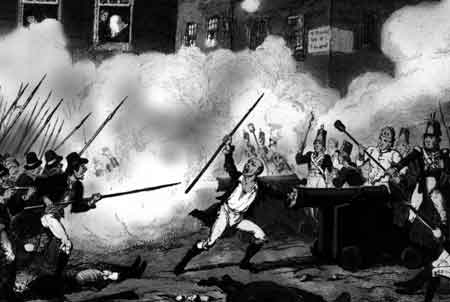 In 1798 Ireland was shook by a mass rebellion for democratic rights and against British rule. 200 years later 1798 continues to loom over Irish politics. The bi-centenary, co-inciding with the 'Peace process', has attracted considerable discussion, with the formation of local history groups, the holding of conferences and a high level of interest in the TV documentaries and books published around the event.
In 1798 Ireland was shook by a mass rebellion for democratic rights and against British rule. 200 years later 1798 continues to loom over Irish politics. The bi-centenary, co-inciding with the 'Peace process', has attracted considerable discussion, with the formation of local history groups, the holding of conferences and a high level of interest in the TV documentaries and books published around the event.
Sinn Fein and the 'Peace Process'
The 'Irish peace process' is now well into its second year. It has brought respectability for Sinn Féin but little of consequence for the Irish working class - North or South. Gregor Kerr a member of the National Committee of the Irish Anti Extradition Committee in the late 1980s, looks at events leading up to the cease-fire and Sinn Féin's pan-nationalist strategy.
Since the ending of the 'Cold War', many national liberation struggles throughout the world have been 'settled'. In places as far apart as South Africa, El Salvador, Nicaragua and Palestine these national liberation struggles were led by groupings which were often seen as having left leanings. However in all of these cases the 'settlement' was far from socialist. The current 'Irish peace process' is following exactly the same lines and has nothing to offer the Irish working class North or South
The Dublin Lock-out of 1913 and the ITGWU
In 1913 militant trade unionism had a tremendous task ahead of it. The poverty of manual workers was appalling. The death rate in Dublin, 27.6 per 1OOO, was as high as Calcutta's, The slums were the worst of any city in either Ireland or Britain. 20,108 families were recorded as living in a single room. An Irish Times editorial commenting on a report about Dublin housing wrote that "28,000 of our fellow citizens live in dwellings which even the Corporation admits to be unfit for human habitation. Nearly a third of our population so live that from dawn to dark and from dark to dawn it is without cleanliness, privacy or self respect. Sanitary conditions ruled out ordinary standards of savage morality''

